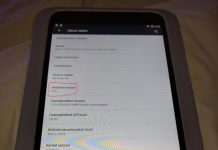Android by and large hasn’t changed all that much from a user standpoint over the last several versions, except in little cosmetic flourishes and new features that are handy but hardly critical (like a built-in flashlight button on the pull-down panel). Older versions of Android still run most e-reading applications just fine (as shown by how Michael Kozlowski’s 13” e-ink reader as originally announced would ship with Android 4.0.4). Nonetheless, Apple partisans get a lot of mileage out of poking fun at an operating system where only 7.5% of users are on the latest version after much of a year of availability.
Google has done what it can to minimize the problems with running older versions, including moving as many operating system features as it can to the Google Play Services framework that it can update. As a result, versions of Android as old as 4.2 Jelly Bean will be able to make use of the new Instant Apps feature. But Google still has to contend with devices stuck on older versions with security loopholes and vulnerabilities that can’t be patched via operating system updates because they don’t get operating system updates. Most average users will probably never encounter a situation where those loopholes could be taken advantage of, but some might.
So Google is looking at other things it can do to try to spur faster updates. Its latest bright idea is to put out a list of slow-to-update OEMs, “shaming” the slower-to-update ones by prominently listing their names. (“They’d none of them be missed, they’d none of them be missed.”) Such a list would certainly be handy for me, and others similarly in the know, when it came to picking a good next Android device.
My current rule of thumb is to buy only Android devices with the Google brand name on them when I can, because I know they’ll come with a good several years’ worth of operating system updates built in. (Though as the Nexus 9’s track record indicates, even that can be iffy.) It would be nice to have a list telling me what other fast-to-update options are available.
However, the problem with that is that, short of a major marketing campaign, Google’s “little list” probably won’t be noticed by many people, and it will be easily counteracted by the millions of dollars the OEMs pour into marketing. An Ars Technica UK op-ed suggests that Google needs to find some way to give OEMs a financial incentive to push upgrades, such as by reducing ad revenue sharing to OEMs that don’t push out updates, and increasing it to OEMs who do. “Threatening to shift the stock price of an OEM by affecting its bottom line is the nuclear option,” writes Ars columnist Ron Amadeo, “and, folks, we’re at the point where the nuclear option is all that’s left.”
Another possibility comes in a column on The Verge (via Slashdot), suggesting that, since it’s clearly uneconomical for OEMs to provide support to older devices on the razor-thin profit margins currently on the market, OEMs should charge their users for Android updates. It can cost several hundred thousand dollars to roll out an update for just a single model of phone. If Google and the OEMs between them can’t, and carriers certainly aren’t going to either, maybe users should chip in to buy themselves an OS update.
What I’m proposing is a simple crowdfunding operation. Say you really want HTC to deliver Android Marshmallow to your 2013 One max phablet. HTC can set up a Kickstarter that identifies the cost required to make that update rollout feasible, and then it’s up to you and your fellow One max owners to gather the funds for that service. This is the thing that goes unappreciated: an operating system update for smartphones, by virtue of all the carrier approvals required on a global scale, is actually a major undertaking and a real service.
I’m not sure how realistic a solution that is—but then, I’m not sure how realistic Google’s list or the notion of pressuring OEMs with revenue sharing is either, given how much those updates cost to roll out. It may well be that the only sure course for consumers who want the latest and greatest is to keep buying Google-branded products when they can.






























